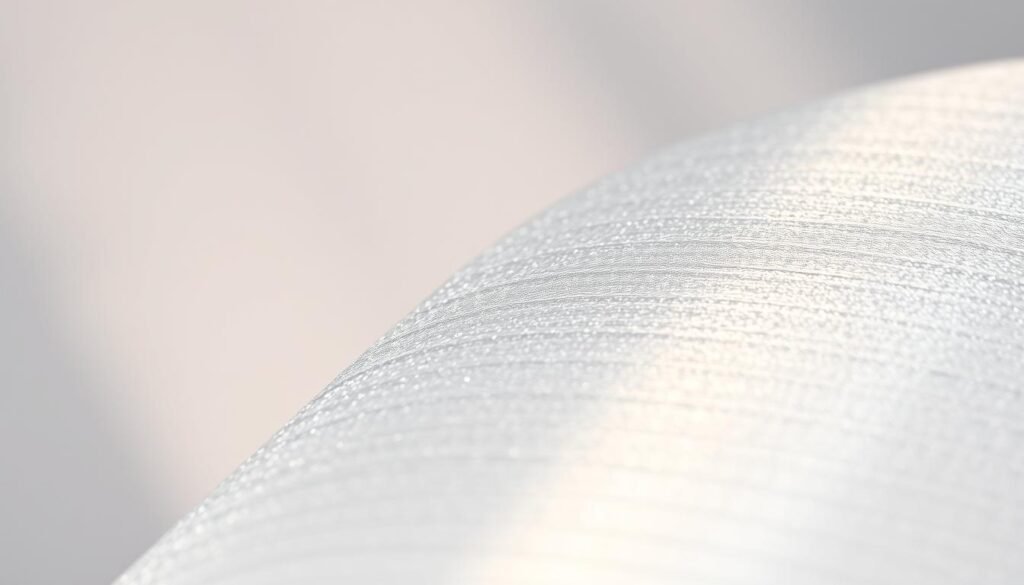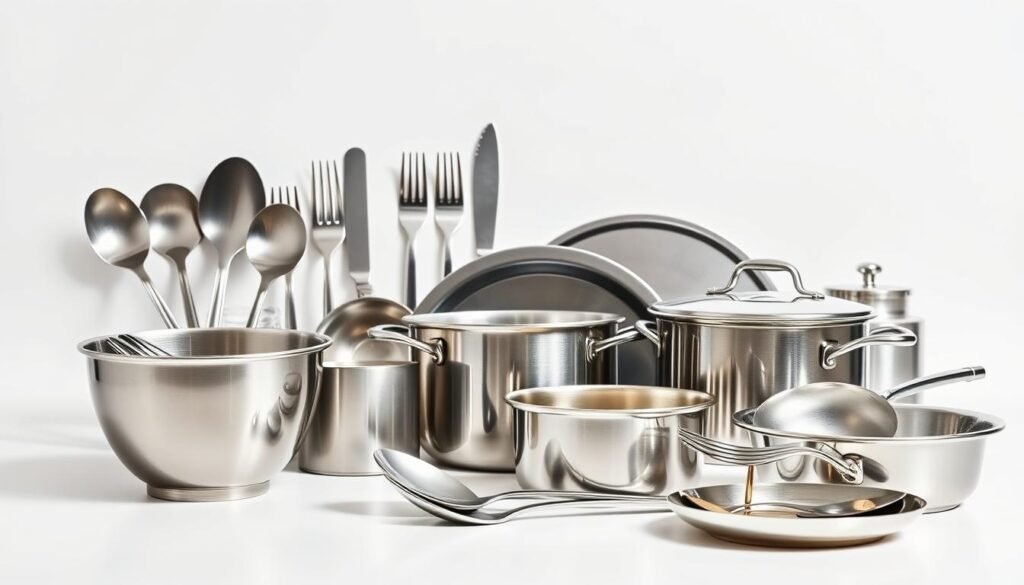High-quality stainless steel is a crucial material in kitchenware and cookware due to its durability and resistance to corrosion.
The term “18/10 stainless steel” refers to its composition, containing 18% chromium and 10% nickel. This alloy provides excellent corrosion resistance and a hygienic finish, making it ideal for cookware and cutlery.
Consumers often seek information about the quality and performance of 18/10 stainless steel compared to other grades like 18/8 and 18/0. The difference lies in the nickel content, which affects the material’s durability and shine.
By examining the properties and characteristics of 18/10 stainless steel, consumers can make informed decisions about their purchases, ensuring they invest in high-quality products that meet their needs.
What Is 18/10 Stainless Steel?
The 18/10 stainless steel designation is more than just a number; it signifies a particular composition that enhances its usability and longevity. This specific grade of stainless steel is widely used in kitchenware, cookware, and flatware due to its excellent properties.
Understanding the Composition
18/10 stainless steel is a high-quality alloy primarily composed of iron, with significant percentages of chromium and nickel added to enhance its properties. The addition of chromium provides the steel with its corrosion resistance properties by forming a passive chromium oxide layer on the surface. Nickel further enhances the protective qualities of chromium while improving the steel’s formability.
The chemical composition of 18/10 stainless steel typically includes:
| Element | Percentage |
|---|---|
| Chromium | 18% |
| Nickel | 10% |
| Iron | 66-71% |
| Manganese, Silicon, Carbon | Trace amounts |
The Meaning Behind the Numbers
The designation “18/10” directly refers to the composition of the steel, indicating it contains approximately 18% chromium and 10% nickel content. Understanding these numbers helps consumers make informed decisions when purchasing kitchen tools and other stainless steel products. The specific composition gives 18/10 stainless steel its characteristic shine and luster, making it aesthetically pleasing for visible applications.
The manufacturing process for 18/10 stainless steel involves melting scrap steel in an electric arc furnace, then adding precise amounts of chromium and nickel to achieve the desired composition. This process ensures that the final product has the desired properties, including corrosion resistance and durability.
Properties and Characteristics of 18/10 Stainless Steel
Understanding the properties of 18/10 stainless steel is crucial for determining its suitability for different applications. This alloy is known for its unique combination of characteristics that make it highly versatile.
Physical Properties
The physical properties of 18/10 stainless steel include a density of 7.9 g/cm³, a yield strength of 200 MPa, and a Rockwell B hardness of approximately 75. It is also notable for being non-magnetic, which is a result of its austenitic structure. These physical attributes contribute to its durability and aesthetic appeal.

Corrosion Resistance
One of the standout features of 18/10 stainless steel is its superior corrosion resistance. The high chromium content forms a passive layer that protects the underlying metal, while the addition of 10% nickel further enhances its resistance to corrosive elements. This makes 18/10 stainless steel particularly suitable for environments where exposure to moisture, acids, or other corrosive substances is common.
Thermal Properties
18/10 stainless steel also exhibits impressive thermal properties. It has a melting point between 1,400-1,455°C and a thermal conductivity of 15 W/m.K, allowing it to withstand high temperatures without warping or degrading. The rate of thermal expansion is 16.5 x 10^-6 mm/m/°C at 20°C, which is an important consideration for applications subject to temperature fluctuations.
| Property | Value | Unit |
|---|---|---|
| Density | 7.9 | g/cm³ |
| Yield Strength | 200 | MPa |
| Melting Point | 1,400-1,455 | °C |
| Thermal Conductivity | 15 | W/m.K |
How 18/10 Stainless Steel Compares to Other Grades
When evaluating the best stainless steel for a particular application, comparing 18/10 stainless steel to other grades is essential. The primary difference among these grades lies in their composition, particularly the nickel content, which significantly affects their durability, appearance, and corrosion resistance.
18/10 vs. 18/8 Stainless Steel
18/10 and 18/8 stainless steel share a similar chromium content of around 18%, but they differ in their nickel content—10% for 18/10 and 8% for 18/8. This difference gives 18/10 stainless steel slightly better corrosion resistance and a brighter surface finish. While 18/8 stainless steel offers good corrosion resistance for most applications, it may not perform as well as 18/10 in highly corrosive environments or with frequent exposure to acidic foods.
18/10 vs. 18/0 Stainless Steel
The contrast between 18/10 and 18/0 stainless steel is more pronounced. 18/0 contains virtually no nickel (less than 1%), making it more susceptible to corrosion and less durable over time compared to 18/10. Additionally, 18/0 stainless steel is magnetic due to its low nickel content, whereas both 18/10 and 18/8 are typically non-magnetic—a simple test that can help identify different grades of stainless steel.
Quality and Price Considerations
From a quality perspective, 18/10 stainless steel is generally considered superior among these three common types of stainless steel, particularly for applications requiring longevity and resistance to harsh conditions. The price considerations reflect these quality differences: 18/10 commands the highest price, followed by 18/8, with 18/0 being the most economical option. The heat resistance capabilities also vary among these grades, with 18/10 typically offering better performance at high temperatures than 18/0.
Common Applications of 18/10 Stainless Steel
The versatility of 18/10 stainless steel makes it a popular choice for various applications, from kitchenware to industrial equipment. Its durability, corrosion resistance, and aesthetic appeal contribute to its widespread use across different industries.
Kitchenware and Cookware
18/10 stainless steel finds its most common application in high-quality kitchenware and cookware, where its corrosion resistance and durability make it ideal for daily use with various foods and cooking methods. Premium cookware manufacturers often highlight the 18/10 stainless steel construction of their products as a mark of quality and longevity, particularly for the cooking surfaces that come in direct contact with food.
Cookware made from 18/10 stainless steel can handle high temperatures and acidic foods without corroding, making it a preferred choice for cooking enthusiasts. The material’s ability to distribute heat evenly also contributes to its popularity in cookware.
Flatware and Utensils
In the flatware industry, 18/10 stainless steel flatware is considered top-tier, offering superior resistance to tarnishing and maintaining its luster even after years of regular use and dishwasher cleaning. The weight and balance of 18/10 steel flatware are often preferred by fine dining establishments and discerning home users who appreciate the substantial feel and elegant appearance.
- Durable and resistant to corrosion
- Maintains luster over time
- Preferred by fine dining establishments
Other Household and Industrial Uses
Beyond kitchen applications, 18/10 stainless steel is used in medical instruments and healthcare environments where its non-porous surface and resistance to corrosion make it suitable for sterilization. It is also found in food processing equipment, brewery equipment, and chemical processing vessels, where both aesthetic appeal and functional durability are required.

The versatility of 18/10 stainless steel allows manufacturers to create products ranging from simple flatware to complex industrial machinery, all benefiting from its exceptional properties.
Advantages and Disadvantages of 18/10 Stainless Steel
Understanding the pros and cons of 18/10 stainless steel is essential for making informed decisions about its use. This material is widely utilized in various applications due to its unique properties.
Benefits for Everyday Use
The primary advantage of 18/10 stainless steel is its exceptional corrosion resistance, attributed to its high chromium (18%) and significant nickel (10%) content. This combination prevents rust and tarnishing, maintaining the material’s appearance over many years. Products made from 18/10 stainless steel are a worthwhile long-term investment despite the higher initial price. The material’s heat resistance makes it ideal for food preparation, as it withstands high temperatures without warping or releasing harmful substances.
Additionally, 18/10 stainless steel is highly resistant to staining and pitting, even when exposed to acidic food or harsh cleaning chemicals. Its aesthetic appeal is superior to many other metals, with a bright, mirror-like finish that enhances the appearance of flatware and kitchen appliances.
Limitations to Consider
Despite its many benefits, 18/10 stainless steel has some limitations. The higher nickel content makes it more expensive than other grades with lower nickel percentages. It is also prone to scratching, which can affect its appearance over time if not properly maintained. Furthermore, the non-magnetic nature of 18/10 stainless steel can be a limitation in certain applications, such as those involving induction cooktops.
Conclusion
With its optimal balance of chromium and nickel, 18/10 stainless steel is the go-to material for premium kitchen tools and flatware. It outperforms other grades like 18/8 and 18/0 stainless steel in terms of corrosion resistance and durability. Although it may come at a higher initial cost, its extended lifespan and superior performance make it the more economical choice in the long run. For consumers seeking high-quality stainless steel products that maintain their appearance and functionality, 18/10 is the recommended grade.
